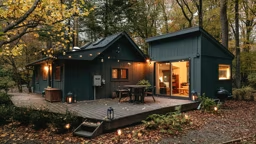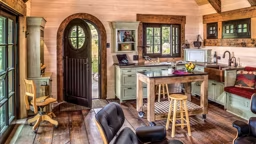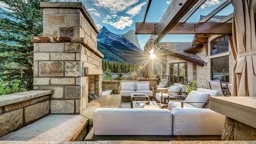Taking the lessons learned by this country’s earliest settlers – and combining them with today’s modern milling machinery – log home manufacturers have the ability to create stunning log homes of any size, with amenities limited only by your imagination.
Like any new home purchase, you’ll want to do your homework before buying your log home. But unlike buying other new homes, log home buyers will find some special characteristics unique to the industry.
Design Your Dream
A log home is a realized dream and a reward for years of hard work. One of the easiest ways to make this dream a reality is to begin your search for a log home manufacturer with your personal design ideas in mind.
You don’t have to have a perfectly designed floor plan in hand, but you should take the time to consider what elements of a home are most important to you: Do you want a vast great room for entertaining family and friends? How many bedrooms will you need to accommodate visitors? How will your finished home lie on the home site?
The goal is to have a vision of a floor plan so that you’ll be able to concisely explain your needs to a designer and properly evaluate the plans shown to you. As you define your needs, have in mind a realistic budget and be prepared to share it.
Selecting the Right Partners
When building a new conventional home, the primary point of contact is the builder. The builder handles nearly every aspect of construction and where he gets his materials and to whom he subcontracts is never much of an issue. That’s not always so with log homes.
Your first contact when building a log home is often a log home package manufacturer – a company that, depending on its services, will cut logs to precise lengths, dry the logs and engineer your home plans. Often, these manufacturers will have a network of dealers and builders across the country and will refer you to a point-of-contact in your area.
If you prefer a more rustic style, you may want to consider handcrafted log homes. The logs used in handcrafted homes are hand-peeled and each timber retains its natural taper and shape as your home is planned and constructed. Some companies specialize in handcrafting and some manufacturers have handcrafted log divisions.
Selecting a manufacturer is one of the key decisions a log home buyer will make, and there are some safeguards to ensure you choose wisely. For starters:
- To whom is the manufacturer accountable? Are they members of their local homebuilders’ association? Are they members of the Log Homes Council or the International Log Builders Association? Are there any complaints registered with the Better Business Bureau?
- Who grades their logs? All logs are not created equal! To ensure the integrity of structural timbers, organizations like the Log Homes Council mandate that their members enroll in a certified, third-party log grading program. That way, consumers can be confident in the quality of their wood.
- How are their homes built? With so many options – from wood species, profile and corner styles, and sealants and coatings – each log home is unique. Be sure each manufacturer has a construction manual that clearly states the ideal way to build their home. You might not be building it yourself, but a construction manual will be your guide to know that your home is built properly.
Additional research can be done by reading consumer magazines and attending log home- and cabin-oriented shows in a city near you (examples include the annual Lake Home and Cabin Shows in Minneapolis and Milwaukee or the Adirondack Living Shows in upstate New York). At shows like these you’ll find manufacturers exhibiting, as well as vendors to the log home industry. Attending these shows allows savvy consumers the chance to meet with a variety of manufacturers under one roof in one day. Most shows also include free seminars on topics including maintenance or financing
a log home.
Understanding the Package
When receiving estimates from multiple log home manufacturers, be sure to inquire about the nature and quantity of materials included in their log home package.
Some manufacturers include only the cost of the logs in their estimate, leaving the responsibility of completing the home to you and your builder. Other companies include a more comprehensive materials package and might even offer a “turnkey” estimate, accounting for the cost of completing every aspect of the home.
While it’s difficult to compare estimates from companies offering different products or packages, take note of the following costs (or omissions) in each estimate:
• Wall logs & related materials
• Rafters & second-floor beams
• Windows & exterior doors
• Partition framing materials
• Roof systems
• Porches & decks
• Interior doors & trim materials
• Stair & railings
• Hardware
• Floor & loft systems
Fully understanding what is included in your log home package will give you a better sense of how each company’s estimate will factor into your final budget.
Finishing the Dream
Once you have narrowed your selection of manufacturers to one or two, you should start thinking about your home’s construction. Your manufacturer or their representative should be able to provide you with an estimated final cost for your area.
Having a log home built is often described as a “labor of love.” It is true that the research involved with log home construction is different and sometimes more complicated than a conventional home. However, nearly every log home owner will say it is worth every penny – and second – spent.










